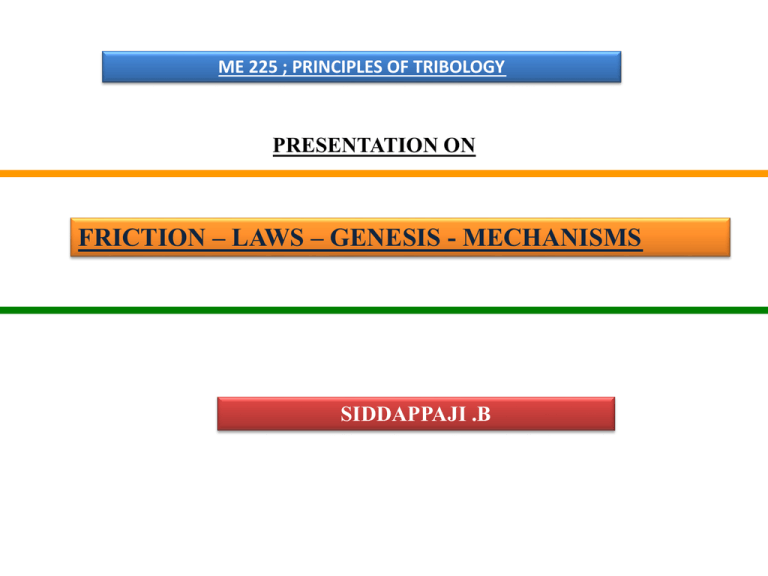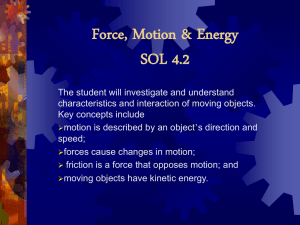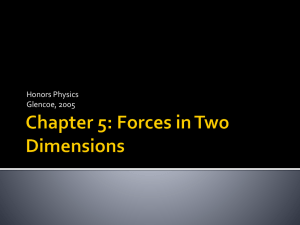FRICTION - Department of Mechanical Engineering
advertisement

ME 225 ; PRINCIPLES OF TRIBOLOGY PRESENTATION ON FRICTION – LAWS – GENESIS - MECHANISMS SIDDAPPAJI .B FRICTION • A force that resists the relative motion or tendency to such motion of two bodies in contact. • Friction always works in the direction opposite from the direction the object is moving, or trying to move. • Friction always slows a moving object down. • Friction also produces heat. • Keep frictional forces as small as possible. PLACES WHERE FRICTION IS GOOD • • • • • • • • Prevents our shoes slipping on the pavement when we walk Stops car tyres skidding on the road A nail hammered into a piece of wood Grip between nut and bolt The feet of table legs Rock climbing holds Brakes Ice causes very little friction, hence it is easy to slip over on an icy day. good thing for ice skating and sledging. PLACES WHERE FRICTION IS BAD • • • • • Sometimes we want to reduce friction In engines In transmissions On the bottoms of skis and snowboards (To a point) When you are trying to move a box by pushing it along the floor CLASSICAL LAWS OF FRICTION v 1) Ff = FN FN= Normal Force 2) independent of apparent contact area 3) independent of sliding speed 1, 2 3 Guillaume Amontons, 1699 Charles-Augustin de Coulomb, 1785 Ff m mg FN depends on whether object is at rest or moving - “static friction” vs. “kinetic friction”. s k Third Amontons Law Meanwhile, for solid-liquid interfaces, “viscous friction” applies, where, F m v Coulomb Friction depended on the asperities of the two surfaces becoming inerlocked Charles-Augustin de Coulomb Théorie des Machines Simple 1785 BASIC MECHANISMS OF DRY FRICTION • Adhesion • Deformation The adhesive force is linked to the asperity-asperity contact W=Load A= True area of contact H= Hardness κ = Shear Strength F=Total Frictional Force Pm = Mean Pressure P= Normal pressure α= constants W=A× H F= A × κ Junction growth phenomenon Pm = =α2 Deformation The deformation component of friction Two opposing asperities in oblique contact near their summits at a small angle, Ө F = Fa + Fd Fa= tangential force Fd= deformation force Deformation continued Width of groove Slope of the asperity pressure c/s area of groove Deformation continued For a cone asperity For a spherical asperity Normal Load and penetration Hardness related Deformation continued Deformation continued FREE BODY DIAGRAM Normal Force FN Applied Force F Friction Force ff Gravity Force Fg Fg = mg FN = Fg ff = F STATIC FRICTION The Force of Static Friction keeps a stationary object at rest! f s FN s FN F fs Fg s coefficient of static friction KINETIC FRICTION Once the Force of Static Friction is overcome, the Force of Kinetic Friction is what slows down a moving object! FN Motion F fk Fg f k FN k k coefficient of kinetic friction STICK-SLIP EFFECTS STATIC & KINETIC FRICTION COEFFICIENTS Material Coefficient of Static Friction S Coefficient of Kinetic Friction k Rubber on Glass 2.0+ 2.0 Rubber on Concrete 1.0 0.8 Steel on Steel 0.74 0.57 Wood on Wood 0.25 – 0.5 0.2 Metal on Metal 0.15 0.06 Ice on Ice 0.1 0.03 Synovial Joints in Humans 0.01 0.003 THANK YOU VERY MUCH v m v Ff m mg FN Ff = FN Amontons, 1699 F = ma Newton, 1686 F






